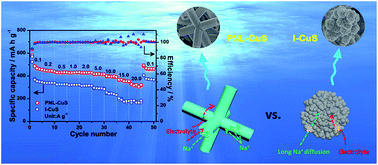Nanotube-assembled pine-needle-like CuS as an effective energy booster for sodium-ion storage†
Abstract
Transition metal sulfides have emerged as attractive anode materials for sodium-ion batteries (SIBs) due to their favorable properties and abundant resources. However, very few metal sulfides are available now that fulfill all criteria regarding specific capacity, rate performance and long-term cyclability for commercial applications. Herein, we report a novel pine-needle-like CuS (PNL-CuS) self-assembled from hollow nanotubes together with its sodium storage properties between 3.0 and 0.3 V. Such a hierarchical architecture benefits the infiltration of the electrolyte, providing more active sites for Na+ storage and facilitating fast charge transfer, as reflected by the high reversible capacity (522 mA h g−1 at 0.1 A g−1), superior rate performance (317 mA h g−1 at 20 A g−1) and outstanding long-term cycle stability (1000 cycles without obvious fading at 5 A g−1) of the resulting materials. Moreover, ex situ HRTEM and ex situ XPS characterization reveal the phase transitions during Na+ uptake. The experimental results are further supported by density functional theory calculations, showing a preferential Na+ transfer pathway and the intrinsic metallic behavior of covellite CuS upon Na+ absorption. The exceptional performance together with a highly reversible conversion reaction indicates that CuS has great potential for large-scale energy storage.



 Please wait while we load your content...
Please wait while we load your content...